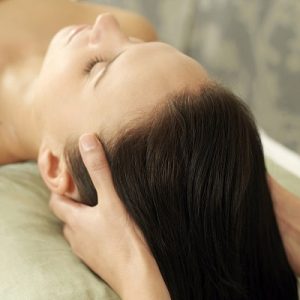 It’s origins stem from an Indian remedial and grooming practice which had been and continues to be part of the Indian daily ritual for over 4,000 years.
It’s origins stem from an Indian remedial and grooming practice which had been and continues to be part of the Indian daily ritual for over 4,000 years.
The ancient Indians believed that when energy channels become blocked and the flow of positive energy is obstructed, negative energy builds up and increasingly leads to a wide array of ailments and dysfunctions such as stress, depression, poor sleeping habits, localized and remote pains and aches, hampered and sluggish blood circulation, overall poor health, as well as loss of hair or baldness.
The main focus and intent of the Indian Head massage, therefore, is to open up the blockages and to allow the positive energy to flow freely through the entire body and in the process to get rid of the amassed negative energy.
Indians in times of yore, young and old and mostly women but not exclusively, sat in large groups and massaged each other’s heads. They began by applying a variety of nut and grain oils (coconut, almond, olive or sesame) which were to nourish the hair and scalp while, at the same time, the massage promoted improved circulation. Today’s modern Indians get their head massage treatments regularly in beauty salons and barber shops.
Indian Head massage was introduced into the Western world in the early years of the 1970’s by Narendra Mehta, a native of Bombay, India and an osteopath and a massage therapist. As countless techniques for Indian Head massage were passed down through the generations, Mr. Mehta developed his own particular technique by integrating the head, neck, and shoulder and massage into a single robust therapy which promotes and elevates the body to heightened states of physical, mental and spiritual health and wellness.
Mr. Mehta branded his comprehensive massage treatment as Champissage. Champi means “head massage” in Indian and it is also, by the way, the origin of the English word “shampoo.” With the help of Mr. Mehta’s promotional campaign, Champissage rapidly gained popularity in Europe and elsewhere around the world, and he summarizes his own belief which, in fact, echoes the belief of his ancestors by making the following statement out of his current home base in London: “Unfortunately, in the West, many people worry about their hair’s health only when they start to lose it. Healthy hair should be promoted from childhood with the help of regular massage.”
The body has seven chakras which are centers that regulate the flow of energy all through the body. Champissage works on the top three energy centers or chakras which are found on the crown of the head, the forehead and the throat as it aims to bring the entire body into corrected alignment and proper balance. The resulting effects are strong, silky and shiny hair, relief from stress, restful sleep patterns, increased energy and sharpened mental clarity.
Indian Head Massage or Champissage is performed in a quiet place where the client can sit comfortably on a chair and the massage therapist can either stand or sit directly behind him or her. The sequence of the treatment is as follows:
- The shoulders. Gently squeezing the trapezoid muscles at the base of the neck and moving outward toward the shoulders. This is repeated three times while slightly increasing the pressure.
- The neck. The neck is massaged with small circular motions, beginning at the collarbone and ending at the hairline. This is repeated three times. The sides of the neck are then stroked with a rolling motion beginning under the jawbone and ending at the shoulders. This is repeated three times. Avoiding the vertebrae, the back of the neck is pressed with a gliding and rotating motion from the collar bone up to the hairline and it is repeated five times.
- The head. The head is moved slowly and gently forward and backward three times. The entire area of the scalp is massaged with rolling gentle pressure four or five times and then the scalp is rubbed briskly without causing pain for a full minute.
- The hair. Fingers are run through the hair from the forehead back three times.
- The temples. The temples are worked with small circular massaging and pressing movements three times.
- The end. Slowly stroking the entire head area from the forehead to the back for a minute and progressively making the strokes lighter and lighter.






